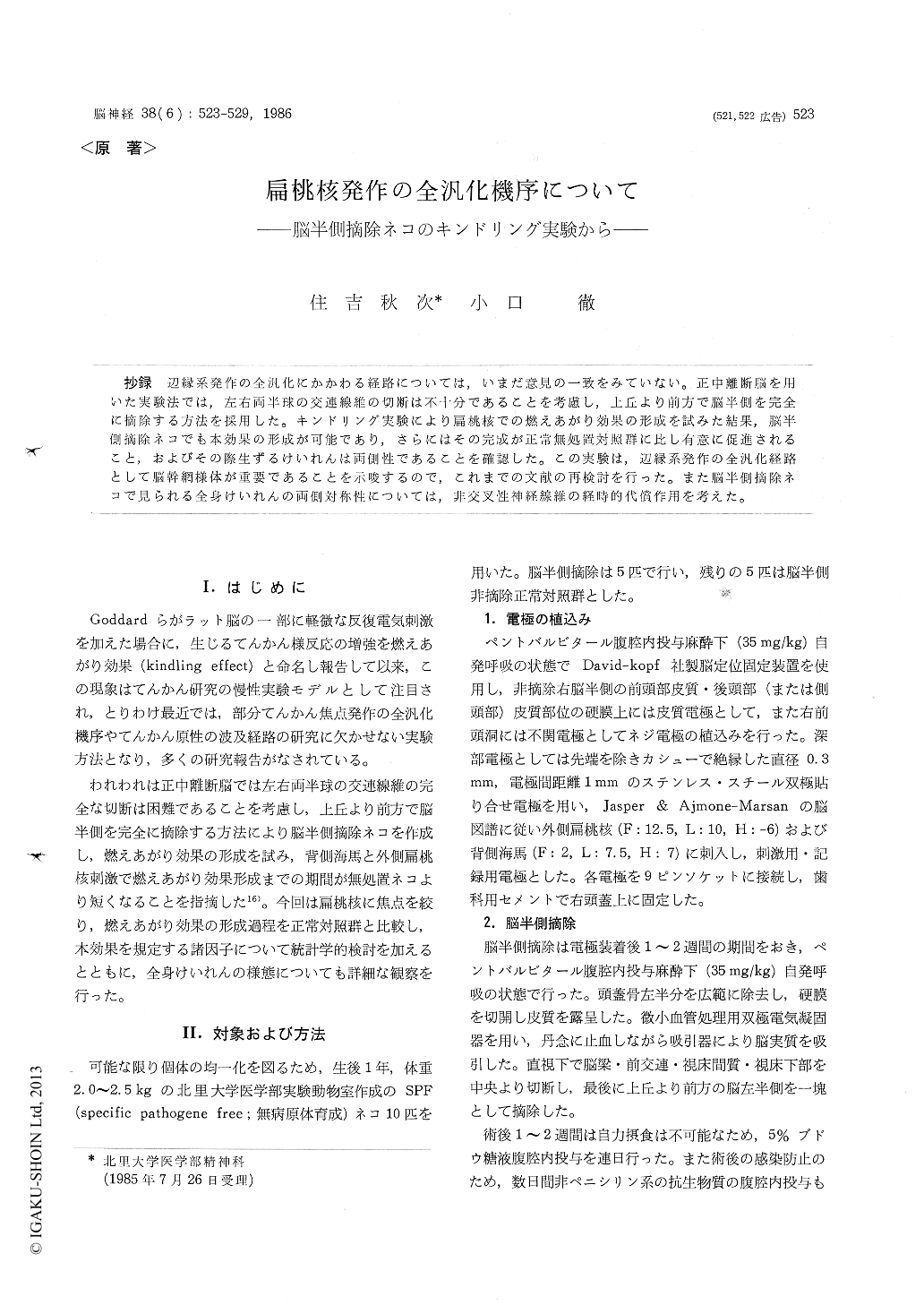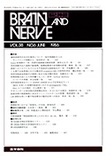Japanese
English
- 有料閲覧
- Abstract 文献概要
- 1ページ目 Look Inside
抄録 辺縁系発作の全汎化にかかわる経路については,いまだ意見の一致をみていない。正中離断脳を用いた実験法では,左右両半球の交連線維の切断は不十分であることを考慮し,上丘より前方で脳半側を完全に摘除する方法を採用した。キンドリング実験により扁桃核での燃えあがり効果の形成を試みた結果,脳半側摘除ネコでも本効果の形成が可能であり,さらにはその完成が正常無処置対照群に比し有意に促進されること,およびその際生ずるけいれんは両側性であることを確認した。この実験は,辺縁系発作の全汎化経路として脳幹網様体が重要であることを示唆するので,これまでの文献の再検討を行った。また脳半側摘除ネコで見られる全身けいれんの両側対称性については,非交叉性神経線維の経時的代償作用を考えた。
In our present experiment, we intend to com-pare the hemispherectomized cats with the intact ones on the time latency for the completion of the kindling effect as well as on the develop-mental pattern of the clinical seizure manifestation.
Ten cats weighing from 2.0 to 2.5kg aged one year were used. Among them, five cats were used for normal controls. Electrodes were implanted in the dorsal hippocampus, the lateral amygdala and the cortical surface (frontal and occipital) of the right hemisphere under the intraperitoneal pentobarbital administration. One or two week after implanta-tion of the electrodes, the left cerebral hemisphere was totally ectomized in a block including the subcortical structures such as amygdala, hippocam-pus, thalamus and hypothalamus down to the col-liculus superior. One month following the left hemispherectomy, the cats were electrically stimu-lated daily at the after-discharge threshold inten-sity in the right lateral amygdala. All the exam-ined cats was further stimulated five more times after they had reached the final stage of seizure.
The five kindled cats reached the final stage of generalized convulsive seizures in 6, 10, 8, 10 and 3 times respectively (7.4±3.0 times; mean±SD). The time latency for the completion of kindling effect of the operated cats was significantly shorter than that observed in the control animals (21.0±5.5 times; n=5, p<0.01). The after-discharge threshold intensity was from 200 to 600 μA and the generalized seizure triggering threshold inten-sity was from 100 to 500 μA. The average of after discharge duration in the final stage of seizure was 71.5±18.2sec. All the result was, however, not significantly different from those of the cont-rol animals.
With regard to the development of the clinical seizure pattern according to the criteria of the degree (Wada et al., 1974), four in five cats reach-ed stage 2 (bilateral facial twitching) even at the first stimulation. All the examined cats showed typically bilateral facial twitching and clonic-tonic convulsions, although there was a tendency of being rather weak in the right side.
On the basis of our data, we suggest that the vertical limbic-brainstem connection plays impor-tant role in the propagation of the amygdaloid seizure and the opposite cerebral hemisphere might play a mere supressive influence in the propaga-tion of the seizure through the corpus callosum, massa intermedia etc.
As to the clinical seizure manifestation, we observed the symmetrical seizure pattern not only in the facial twitching but also in the genera-lized convulsions. Almost all the reports concern-ing split brain animals commented the asymmetry of generalized tonic-clonic seizures. The reason why we gained the different result might be due to existence of the compensational neuronal ipsi-lateral pathway.

Copyright © 1986, Igaku-Shoin Ltd. All rights reserved.


